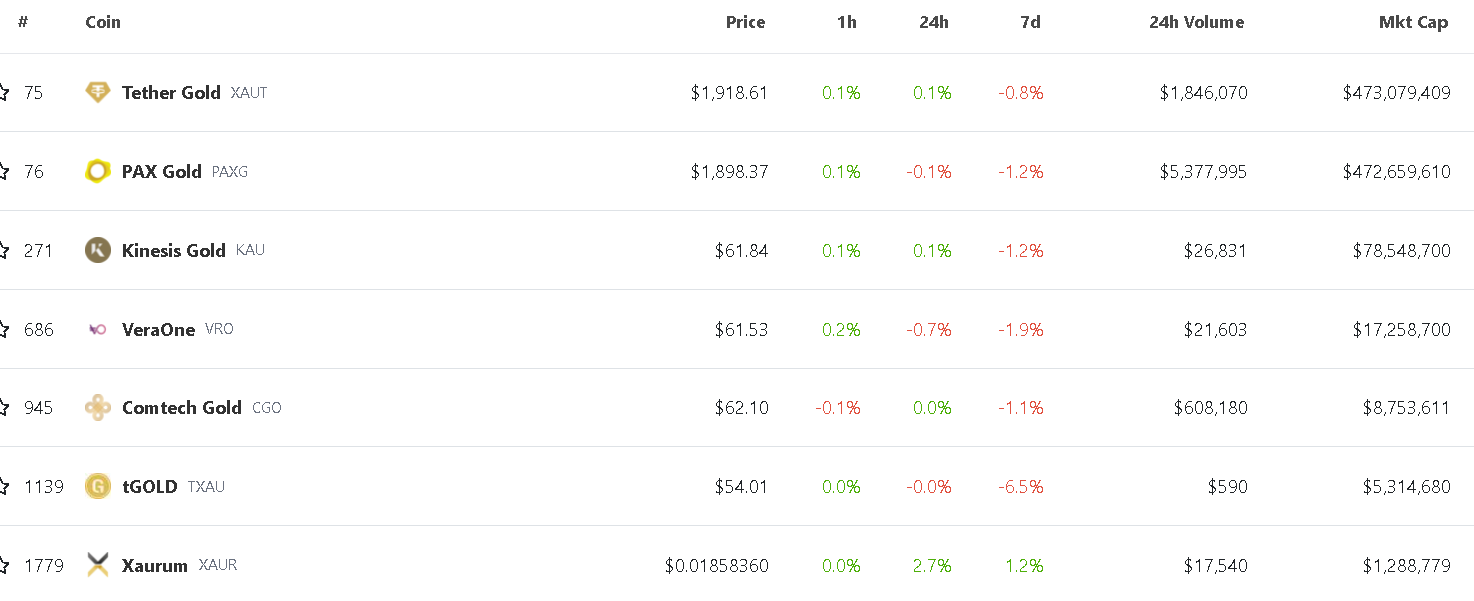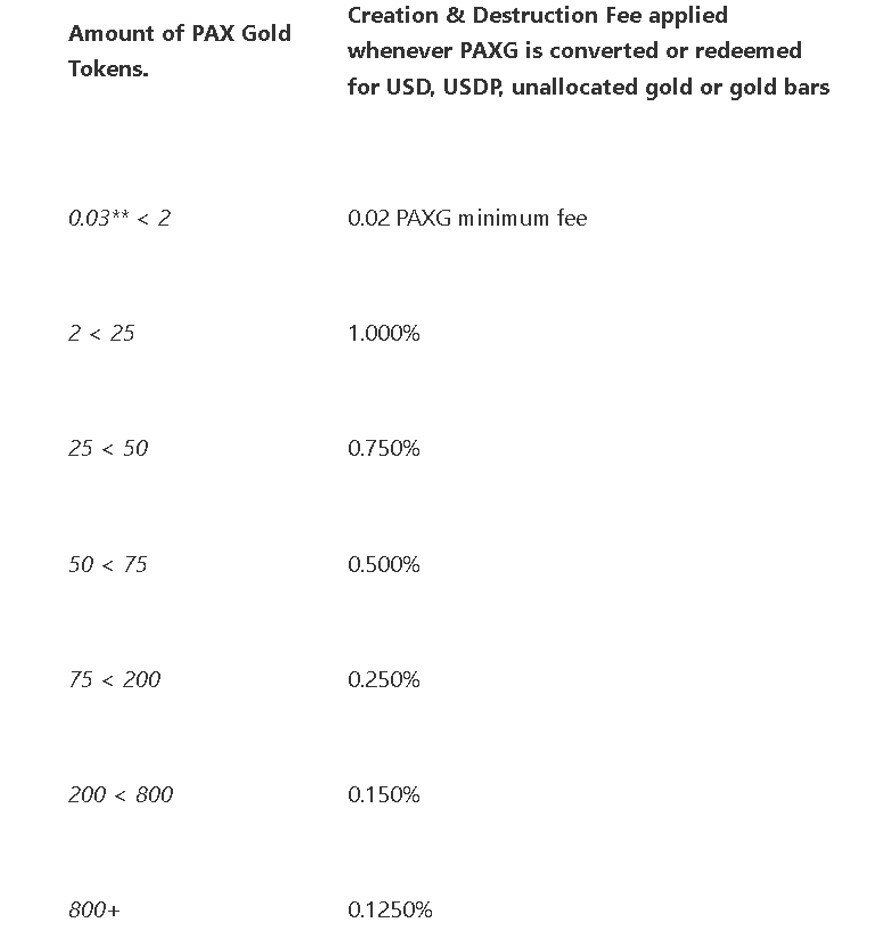Gold has long been recognised as a great risk hedge asset. However, the bulk of the investment in gold has traditionally been routed via the commodity market (in the form of gold futures) or the stock market (in the form of gold ETFs and equities of gold-related companies). Things are changing fast though, and this year has brought about a massive increase in gold investments via a new route – cryptocurrency-based tokenised gold assets. In this article, we will take a detailed look at the two leading crypto assets in this niche – Tether Gold (XAUT) and PAX Gold (PAXG).
Tokenised Gold Niche of Cryptocurrency Market
Gold ownership backed by cryptocurrency tokens is the key idea behind a number of crypto projects. At the moment, the popular crypto aggregator portal Coingecko.com lists 12 cryptocurrencies within its “tokenised gold” category, although only 7 of these have any market cap data. The majority of the gold-related cryptocurrencies have miniscule trading volumes and market caps.
However, two cryptos stand head and shoulders above the rest in this category – Tether Gold (XAUT) and PAX Gold (PAXG). These are the only crypto projects that feature significant trading activity and market caps in the tokenised gold niche.
The 7 tokenised gold cryptocurrencies with reported market caps as of 10 September 2023

Image source: Coingecko.com
The image above clearly shows the duo’s dominance in this category (see the last column for market caps). It also demonstrates that the other tokenised gold projects remain at a stage of minimal activity. In other words, if you are serious about investing in gold via crypto, XAUT and PAXG are the only liquid options as of today.
XAUT and PAXG have nearly identical market caps (both around $473 million), with the former currently leading by a tiny margin. This close, nose-to-nose market cap race has been the usual scenario between the two cryptos over the last few months. In recent times, the cryptocurrencies have also averaged very similar trading volumes - over the last seven days, daily volumes for both XAUT and PAXG have been hovering around the $6 million mark.
XAUT and PAXG in Nutshell
The functionality and core principles behind these two cryptos are similar – both projects allow you to own physical gold locked in a secure vault and represented by the XAUT and PAXG crypto tokens respectively. The cryptocurrencies essentially act as “ownership certificates” for the physical gold assets you invest in.
The physical gold owned by XAUT holders is kept in vaults in Switzerland, while PAXG-backed gold is stored in London in the vaults of the LBMA (London Bullion Market Association).
Both cryptos maintain a 1:1 peg to the market price of one ounce of gold. The pegs are backed by the gold reserves maintained by the projects’ owner companies – Tether Limited for XAUT and Paxos Trust Company for PAXG. Both cryptocurrencies are based on Ethereum and use the blockchain’s default ERC-20 token standard.
XAUT and PAXG Fees
Tether charges 0.25% of the transaction amount for purchasing XAUT, i.e., becoming an owner of the physical gold represented by the token. The same fee of 0.25% applies when you redeem your investment.
PAXG’s fees vary depending on the amount of tokens being created or redeemed. The table below shows the current fee structure:

Image source: Paxos.com
Based on these fee differences, XAUT purchases and redemptions attract a lower fee than PAXG operations if the number of gold units traded is less than 75. The fees are similar, at 0.25%, for transactions involving between 75 and 200 units. When the transaction amounts are above 200 gold units, PAXG offers lower fees than XAUT.
Based on these fee differences, XAUT purchases and redemptions attract a lower fee than PAXG operations if the number of gold units traded is less than 75. The fees are similar, at 0.25%, for transactions involving between 75 and 200 units. When the transaction amounts are above 200 gold units, PAXG offers lower fees than XAUT.
Thus, based purely on the nominal transaction fees, XAUT might be a slightly better choice for small-scale investments. On the other hand, significant investments in tokenised gold work out cheaper via PAXG. However, the transaction fees are probably a much less critical decision factor when choosing between these cryptos compared to the security of your investment and the stability of the gold pegs.
XAUT vs PAXG – Investment Security
Both XAUT and PAXG have a solid demonstrated history of successfully maintaining their pegs to the gold price, the former since 2020 and the latter since 2019. The market prices of these tokens might slightly differ from each other or from the price of gold depending on the activity on their platforms, but generally, the pegs to gold have been very tight and stable.
Thus, based purely on historical data, investors shouldn’t expect any problems with these cryptos. However, it’s critical to consider the future outlook for these projects, especially given that: a) the crypto market is largely unregulated, b) investments in gold often have a long-term window, and c) most importantly, there are some interesting, and possibly disturbing in the case of XAUT, differences between these projects in terms of their transparency and audit history.
Given no massive difference in fees, similar stability of the gold pegs, and comparable trading volumes, the only large, and potentially critical, difference between XAUT and PAXG lies in their audit histories. Audits are a crucial point for any tokenised gold project claiming to be backed by real, physical gold. It is through independent third-party audits that the claimed gold reserves can be established.
PAXG Audits and Gold Reserves
PAXG is owned by Paxos Trust Company, a New York-based FinTech founded in 2012. The company’s business activities are regulated by the New York State Department of Financial Services.
The gold reserves maintained by the company for PAXG are stored in London, UK at the vaults of the LBMA (London Bullion Market Association). The LBMA is a prominent and internationally recognised trade association for the over-the-counter (OTC) markets for gold and silver bullion. It plays a crucial role in setting standards and ensuring transparency in the global precious metals market. If a company needs to store physical gold, they will be hard pressed to find a more secure and trustworthy custodian than the LBMA.
PAXG’s audit schedule also looks impeccable. Its gold reserves are audited monthly by Princeton, NJ-headquartered international audit advisory Withum. Withum itself was established in 1974 and is currently the 22nd largest accounting firm in the US. While not a Big Four giant, Withum is an established audit and tax advisory that has not been implicated in any scandals or improprieties.
XAUT “Audits” and Gold Reserves
Having observed the exemplary audit practices of PAXG, we expected something similar from its no-less-successful competitor, XAUT. We were mistaken!
XAUT is owned by none other than Tether Limited, the company behind the world’s most actively traded stablecoin, USDT. Tether Limited itself is owned by Hong Kong-based iFinex Inc. As a major player in the crypto market, Tether has often come under scrutiny over the reluctance to open its books to independent audits.
Tether Limited also has a history of being fined by regulators for false claims. In October 2021, the US Commodity Futures Trading Commission (CFTC) levied a $41 million fine on the company for falsely claiming that it had complete USD reserves for its USDT stablecoin.
Last year, facing mounting pressure to do something on the audit front, Tether invited the Italian arm of the US-headquartered BDO audit advisory to conduct quarterly audit “opinion reports” for the company. BDO Italy has been diligently submitting the opinion reports every quarter. Unfortunately, these reports are not full audits, which Tether is still unwilling to establish.
Additionally, while BDO is the 6th largest US accounting advisory, the choice of its Italian arm is perplexing. Tether claims incorporation in Hong Kong, has previously claimed having Swiss offices too, and assures XAUT investors that their physical gold is stored in Swiss vaults. Italy is also far from the largest market for the company.
There is nothing specific in terms of Tether’s operations or history that might suggest a link to the homeland of Leonardo da Vinci and Niccolo Paganini. Why Italy?
Besides the shaky “audit” commitment, Tether also has an incredibly evasive description of exactly how and where its XAUT-linked gold is stored. The company has claimed in its communications that the gold is stored “in a Swiss vault” or “in a Swiss bank vault”. However, the name of the Swiss bank involved or even the city where these vaults are located is an unknown that the company has never clarified in its public communications.
Conclusion
Tokenised gold might be a great investment, particularly for investors who don’t mind the less regulated nature of the crypto industry. Ownership and brokerage fees might actually be lower compared to gold investments via the stock market or the commodity market.
At the moment, tokenised gold niche has two primary players – XAUT and PAXG. While the two projects have many similarities, there is one area where they differ majorly – the transparency of the gold reserves held.
Our research has found that PAXG maintains solid audit and reserve-proof practices. On the other hand, XAUT and its owner company, Tether Limited, have murky audit and gold reserve details. To be specific, Tether doesn’t conduct any full audits for XAUT and remains tight-lipped on exactly where and at which Swiss bank its gold vaults are located. For investors interested in gold, particularly institutional or large-scale retail investors, such details are certainly crucial. For now, PAXG looks like a project with far more transparency and investment security.

